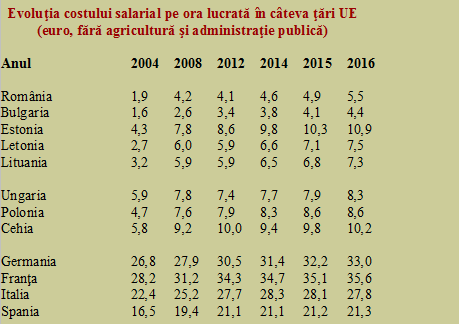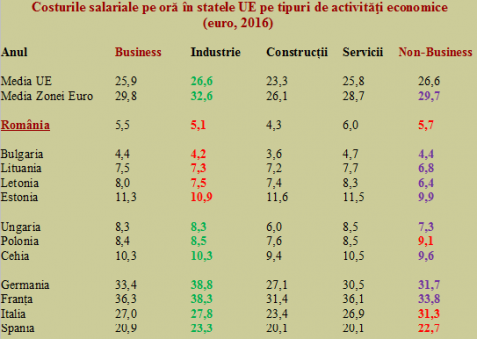 Romania leads by far among the EU countries with the highest growth of the labour costs, according to the Eurostat data for 2016.
Romania leads by far among the EU countries with the highest growth of the labour costs, according to the Eurostat data for 2016.
With an increase of + 11.6% (in euro) registered last year, our country is far ahead of Bulgaria (+7.8%) and the Baltic countries – Lithuania (+7.5%), Latvia (+6.4 %) and Estonia (+5.6%).
To note, the cost for wages in Romania almost tripled in November compared to 2004 and rose by 30% compared to 2008, which shows that this competitive advantage from investors’ perspective is steadily diminishing. So far, this trend (beware, excepting the public administration) is comparable to the situation in the BELL group countries, mentioned above (see table).
*
- Evolution of wage per hour worked in some EU countries (euro, without agriculture and public administration)
- Year
*
Problem is that we are not among the small countries with the currency indexed to euro (adopted in the meantime in the Baltic countries), but we are closer to the middle-sized economies with currencies that have a floating exchange rate regime, such as Hungary, Poland and the Czech Republic. These countries are a few years ahead of us in terms of economic development.
Therefore, we might need to be aware that the growth rate of labour cost, also a few years back considering the rates comparable to ours, fell in the Central Europe somewhere close to a benchmark of 10% over the last eight years (years that just follow for us, given the economic history scale). Large powers Germany, France and Italy also confirm about how much we can go with the wage increases on a solid base (read in euros).
That, unless there are times coming like the period reported in Spain (within the Eurozone), between 2012 and 2014, or Poland (outside the Eurozone), just last year (!), to prove us that we can run around in circles. Because salaries cannot be systematically increased (and substantially, we would like) whenever the economy grows and in any international conditions.
Organization of costs by sectors – a poor distribution in Romania
We clearly differentiate ourselves from the large majority of these countries not only by the strong growth of the costs for wages but also by the distribution of these costs by sectors. To draw some conclusions, beyond the obvious gaps between us and the developed countries, where the leaders by far are Denmark (42 euros/hour), Belgium (39.2 euros/hour) and Sweden (38 euros/hour), we selected from the last year’s Eurostat data the same countries in the table above.
*
- Wage per hour worked in the EU countries by types of economic activities (euro, 2016)
- Year Business Industry Construction Services Non-business
- EU average
- Eurozone average
*
If marked in green the desired situations in the manufacturing sector and in violet the desired situations in the non-business area, at least in relation to the European practice confirmed to have been successful for the development of these economies, and in red the situations that appear to be abnormal in this context, we can easily see to what we should pay attention and in what areas we should adjust the cost for wages to be successful Europeans.
The experience of other countries suggests two key relations for the proper organization of the cost for wages.
1. The business segment should have costs for wages (usually and implicitly salaries) higher than the non-business segment. Only Romania and Poland, in the group of former socialist countries, and Italy and Spain, by contrast with the Franco-German tandem, DO NOT follow this „rule”. Moreover, and very worrying, we are close to placing the non-business segment at a level of excessively high values in relation to the business segment, which is a likely adverse consequences experiment.
2. Within the business segment, it seems to be useful that the industry to be above and not below the sector average, a phenomenon found only in our case and in the BELL group. Furthermore, the greater this correlation, the clearer the results seem to be for the economy (see the situation of our Italian cousins, whom we resemble the most in terms of cost distribution and therefore they cannot compete with Germans). We are, in terms of percentage, with -7% in manufacturing, at the lowest level even among the BELL countries and the opposite of Germany, which, at a cost six times higher than ours (!) has a growth of 16% in manufacturing.











